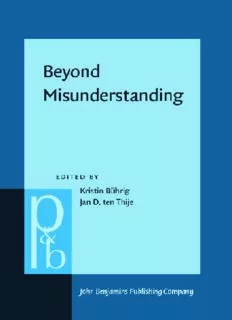Table Of Content<DOCINFOAUTHOR""TITLE"BeyondMisunderstanding:Linguisticanalysesofinterculturalcommunication"SUBJECT"Pragmatics&Beyond,NewSeries,Volume144"KEYWORDS""SIZEHEIGHT"240"WIDTH"160"VOFFSET"4">
BeyondMisunderstanding
Pragmatics&Beyond
Editor
AndreasH.Jucker
UniversityofZurich,EnglishDepartment
Plattenstrasse47,CH-8032Zurich,Switzerland
e-mail:[email protected]
AssociateEditors
JacobL.Mey
UniversityofSouthernDenmark
HermanParret
BelgianNationalScienceFoundation,UniversitiesofLouvainandAntwerp
JefVerschueren
BelgianNationalScienceFoundation,UniversityofAntwerp
EditorialBoard
ShoshanaBlum-Kulka CatherineKerbrat-Orecchioni
HebrewUniversityofJerusalem UniversityofLyon2
JeanCaron ClaudiadeLemos
UniversitédePoitiers UniversityofCampinas,Brazil
RobynCarston MarinaSbisà
UniversityCollegeLondon UniversityofTrieste
BruceFraser EmanuelSchegloff
BostonUniversity UniversityofCaliforniaatLosAngeles
ThorsteinFretheim DeborahSchiffrin
UniversityofTrondheim GeorgetownUniversity
JohnHeritage PaulO.Takahara
UniversityofCaliforniaatLosAngeles SandraThompson
SusanHerring UniversityofCaliforniaatSantaBarbara
UniversityofTexasatArlington TeunA.VanDijk
MasakoK.Hiraga PompeuFabra,Barcelona
St.Paul’s(Rikkyo)University RichardJ.Watts
DavidHoldcroft UniversityofBerne
UniversityofLeeds
SachikoIde
JapanWomen’sUniversity
Volume144
BeyondMisunderstanding:
Linguisticanalysesofinterculturalcommunication
EditedbyKristinBührigandJanD.tenThije
Beyond Misunderstanding
Linguistic analyses
of intercultural communication
Editedby
Kristin Bührig
UniversitätHamburg
Jan D. ten Thije
UtrechtUniversity
JohnBenjaminsPublishingCompany
Amsterdam(cid:1)/(cid:1)Philadelphia
TM Thepaperusedinthispublicationmeetstheminimumrequirements
8
ofAmericanNationalStandardforInformationSciences–Permanence
ofPaperforPrintedLibraryMaterials,ansiz39.48-1984.
LibraryofCongressCataloging-in-PublicationData
BeyondMisunderstanding:Linguisticanalysesofinterculturalcommunication
/editedbyKristinBührigandJanD.tenThije.
p. cm.(Pragmatics&Beyond,NewSeries,issn0922-842X;v.144)
Includesbibliographicalreferencesandindexes.
1.Interculturalcommunication.I.Bührig,Kristin.II.Thije,JanD.
ten.III.Pragmatics&beyond;newser.,144.
P94.6.B49 2006
302.2--dc22 2005057190
isbn9027253870(Hb;alk.paper)
©2006–JohnBenjaminsB.V.
Nopartofthisbookmaybereproducedinanyform,byprint,photoprint,microfilm,or
anyothermeans,withoutwrittenpermissionfromthepublisher.
JohnBenjaminsPublishingCo.·P.O.Box36224·1020meAmsterdam·TheNetherlands
JohnBenjaminsNorthAmerica·P.O.Box27519·Philadelphiapa19118-0519·usa
TSL[v.20020404] Prn:6/02/2006;14:48 F:PB144CO.tex / p.1(v)
Table of contents
Beyondmisunderstanding:Introduction 1
JanD.tenThije
PartI. Basicassumptionsofthelinguisticreconstruction
ofinterculturalcommunication
Multilingualrepertoiresandtheconsequencesforlinguistictheory 11
GeorgesLüdi
Theculturalapparatus:Thoughtsontherelationshipbetween
language,culture,andsociety 43
JochenRehbein
Notionsofperspectiveandperspectivisinginintercultural
communicationresearch 97
JanD.tenThije
PartII. Interactiveanalysesofinterculturaldiscourse
Perspectivesinconflict:AnanalysisofGerman-Germanconversations 155
GritLiebscher
Beyond‘misunderstandings’and‘culturalstereotypes’:Analysing
interculturalcommunication 175
JenniferHartog
Interculturalcommunicationininstitutionalcounsellingsessions 189
MartinaRost-Roth
Ethnicandsocialgroupsandtheirlinguisticcategorization 217
DennisDay
TSL[v.20020404] Prn:6/02/2006;14:48 F:PB144CO.tex / p.2(vi)
Tableofcontents
“Howareyou?”“I’mhot”:Aninteractiveanalysisofsmalltalk
sequencesinBritish-Germantelephonesales 245
ClaudiaBubel
Wheredo‘we’fitin?:Linguisticinclusionandexclusion
inavirtualcommunity 261
LiseFontaine
Communicatingaffectininterculturallamentations
inCaucasianGeorgia 289
HelgaKotthoff
Beyondcompetence:Amulticulturalistapproach
tointerculturalcommunication 313
Shi-xu
AuthorsofBeyondMisunderstanding 331
Index 335
TSL[v.20020404] Prn:6/02/2006;14:28 F:PB144IN.tex / p.1(1)
Beyond misunderstanding
Introduction
JanD.tenThije
This volume challenges two tacit presumptions in the field of intercultural
communication research. Firstly,misunderstandingscan frequentlybe found
ininterculturalcommunication,although,onecouldnotclaimthatintercul-
tural communication is constituted by misunderstandings alone. The main
purposeofthecontributionstothisvolumeistoreconstructinterculturalun-
derstanding linguistically.Secondly,interculturalcommunicationisnotsolely
constitutedbythefactthatindividualsfromdifferentculturalgroupsinteract.
Eachcontributionofthisvolumeanalysestowhatextentinstancesofdiscourse
areinstitutionallyand/orinterculturallydetermined.
Thisvolumeshowshownewperspectivesonlinguisticanalysesofintercul-
turalcommunicationgobeyondtheanalysisofmisunderstanding.Infact,the
volumedocumentsashiftintheresearchfocustowardsthequestionastowhat
extentdifferentlinguisticmeanscontributetointerculturalunderstanding.
EdwardT.Hall(1959,1981)isconsideredtobethefirstscholar,whoused
the notion of ‘intercultural communication’ in order to denote the specific
communicationconstellationthatoccurswhenpeoplefromdifferentcultural
backgrounds meet. His statement ‘culture is communication’ inspired many
scholarsfromanthropology,ethnography,culturalpsychologyandcommuni-
cationstudiestoattempttooffercausalexplanationsofcommunicativefailure
andsuccessininterculturalcontact.Inactualfact,theseanalysesfocusonpsy-
chological,culturalandcommunicativedifferencesacrosscultures(cf.Prosser
1978;Asante1980;Hofstede1980;Bochner1982;Carbaugh1990).
In the eighties of the last century,John Gumperz andcolleagues concen-
trated the research more intensivelyon the intercultural encounteritself and
analysed intercultural misunderstandings in ‘gate keeping situations’. Their
TSL[v.20020404] Prn:6/02/2006;14:28 F:PB144IN.tex / p.2(2)
JanD.tenThije
work on contextualisation has been a bench-mark for the discourse analyti-
cal approach to intercultural discourse (cf. Thomas 1983; Knapp et al. 1987;
Moerman1988;Scollon &Scollon 1994;Müller1999).Thesediscourse anal-
yses raised an animated discussion about the static or dynamic relationship
betweencommunicationandcultureand“howmuchculturecanbefoundin
interculturaldiscourse”(cf.Rehbein1985;Blommaert1991;Koole&tenThije
1994;Ehlich1996).
Srikant Sarangi’s article (1994) “Intercultural or not. Beyond the cele-
brationofculturaldifferencesinmiscommunicationanalysis”exemplifiesthe
beginningofthefore-mentionedshiftinfocusininterculturalcommunication
research. Gradually, scholars incorporate more linguistic notions in their in-
terculturalanalysesand attemptto reconstructhow mutual understandingis
beingachievedindiscourseinsteadofexplainingmisunderstandingbasedon
differentculturalsystems(cf.Clyne1995;Apfelbaum&Müller1998;Tzanne
1999;Kotthoff2002;tenThije2002,2003a,b;Kameyama2004).
This book documents and summarises this discussion beyond the anal-
yses of misunderstandingsin intercultural discourse. The chapters reflect on
thequestionastowhetherlinguisticinvolvementininterculturalresearchhas
resulted in the extension and enhancement of new linguistic categories and
methods.Thesereflectionsinvolvedifferenttheoreticalframeworks(e.g.func-
tional grammar(Lüdi), systemic functional linguistics (Fontaine),functional
pragmatics (Hartog, Rehbein, ten Thije), rhetorical conversational analysis
(Liebscher), ethno-methodological conversational analysis (Bubel, Day, Rost
Roth), an approach from linguistic anthropology (Kotthoff) and a cultural
approach(Shixu)).
Furthermore,interactiveapproaches tothe analysisof interculturalcom-
munication are surveyed, by analysing both authentic and elicited data. As
thecontributionsfocusonthediscourseofcounsellingorgate-keepingsitua-
tions,internationalteamcooperation,internationalbusinesscommunication,
workplacediscourse,internetcommunication,andlamentationdiscourse,the
volume shows that the analysis of intercultural communication is essentially
organizedindirectresponsetosocialneedsand,therefore,contributestothe
socialjustificationoflinguistics.
The volume comprises two parts. Part one discusses basic assumptions.
Inordertomaketheshiftinlinguisticreconstructionfrommisunderstanding
tounderstandingininterculturalcommunication,thepresumptionsofmain-
streamlinguistics–thateverylanguagehastobeconsideredasahomogeneous
entity–arediscussed.Interculturaldiscourseisanalysedasasubstantiveform
ofmultilingualismandnotasadeviationfrommonolingualism.Multilingual-
TSL[v.20020404] Prn:6/02/2006;14:28 F:PB144IN.tex / p.3(3)
Beyondmisunderstanding
ismisacceptedasthestarting pointforthelinguisticanalysisofintercultural
communication.Arelatedbasicassumption concernsthe issue astohowthe
relationshipbetweenlanguageandculturecanbefruitfullyconceptualisedfor
the analysis of intercultural communication. Culture is not considered as a
static set of normsand values(materialized in artefacts) within or for a spe-
cificgroupornationstate,butasthesocialorgroupcapacitytofindsolutions
for recurrent societal needs and standard problems. Culture is interactively
producedandreproducedintheperception,understandingandformationof
reality (ten Thije 2002). Consequently, intercultural communication can be
takenastheconfrontation,overlap,orcompetitionbetween,andsometimesas
theextensionorexclusionof,differentpragmaticandcognitivesystems.Since
cultureisinteractivelyaccomplished,interculturalcommunicationhasthepo-
tentialtoenrichbothlinguisticsystemswithnewdiscursivestructuresoreven
contributetothecreationofnewlinguisticsystemslikediscursiveintercultures.
Thecontributionsinparttwogiveanaccountofinteractiveanalysesofin-
terculturaldiscourse.Thequestionregardingtheconcurrenceofinstitutional
andinterculturaldiscoursestructuresisdiscussedhereindifferentinstitutional
constellations. Their linguistic reconstruction enables intercultural discourse
beyondmisunderstanding.
Contributions
Georges Lüdi discusses the question as to whether the study of phenomena
such as like loan words, interferences and code-switching that often consti-
tuteinterculturaldiscourseareofperipheralinterestforlinguistics,orwhether
the results of research on these so called ‘translinguistic markers’ are of im-
mediate relevance for linguistic theory. He states that these phenomena of
plurilingualismshouldnolongerbeinterpretedfromamonolingualideology,
but be respected as a sign of a rich multilingualism. On the basis of study of
the language varieties of Chiac in Acadia and Italoschwyz in Zurich, he re-
vealshowcode-switchinginthesecasescanbeanalysedasavarietyofitsown.
Consequently,hediscussesthedefinitionof‘language’andtheboundariesbe-
tweendifferent‘languages’.Heconcludesthatshapinglinguisticdifferenceshas
an important identity function and is often politically determined. He states
thatwe needalanguagetheorythatgivesspecial prominencetothe waysthe
interactorsexploitallthelinguisticresourcesattheirdisposal.
Jochen Rehbein elaborates on the concept of cultural apparatus that was
proposed by Redder and Rehbein (1987). The cultural apparatus is a repro-
Description:This book challenges two tacit presumptions in the field of intercultural communication research. Firstly, misunderstandings can frequently be found in intercultural communication, although, one could not claim that intercultural communication is constituted by misunderstandings alone. This volume s

